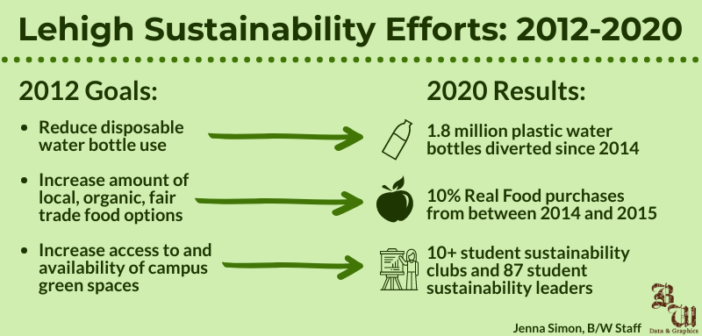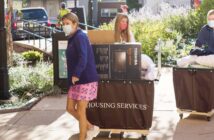Over the last 10 years, Lehigh has made significant strides to become a more sustainable campus. The Lehigh Sustainability Council created a set of goals to achieve by 2020 — including optimizing fuel efficiency and minimizing gas emissions from vehicles on campus, creating sustainable buildings and implementing a waste management plan that would increase recyclables — and looks forward to setting and achieving future goals in a new sustainability plan.
Beginning last semester, the Connections plan altered the way Lehigh students and faculty traveled. Parking became more dispersed across all three Lehigh campuses and new transit schedules increased the number of Campus Connector buses from three to five. The new system allows the buses to stop more frequently.
Lehigh Sustainability Council co-chair Karen Beck Pooley, a city planner and professor of practice in the political science department, spends much of her time thinking about how cities work and how the people who live in them get around.
“Lehigh is increasingly contemplating how it operates, like new ways to navigate between campuses, pathways and walkways,” Pooley said. “Don’t bring up concerns about parking to me, but we’re thinking about how students relying on campus bus services and walking is much more sustainable.”
Brent Stringfellow, associate vice president for Facilities Services and University Architect, said while some people are displeased with parking changes, campus will inherently become more green and sustainable.
Lehigh will become more pedestrian-friendly in the coming years — by cutting down on car usage and increasing use of mass transit, as well as encouraging walking.
Stringfellow said his past three years at Lehigh have corresponded with many of the building efforts and strategic planning initiatives currently taking place.
New projects, such as Path to Prominence buildings, require LEEDS Silver certification, which the STEPS building has. It is a starting point, Stringfellow said, not an end point.
The new residential houses will be LEEDS Silver, a rank based upon a set of criteria to determine how sustainable a project is. Criteria include energy use, materials used, carbon footprint of transportation for the materials, site conditions and stormwater drainage.
“What we try to look at is not just individual projects, but how do these tie into an overall campus vision?” Stringfellow said. “As much as we focus on the sustainable pieces within each project, we also are looking at some of the bigger infrastructure issues that might affect the overall campus.”
With a campus on the side of a mountain, Stringfellow said stormwater is a big issue. He said he is working to understand how to handle run-off and systemic issues, such as if nearby municipalities have a stormwater system that can handle such water rates.
Stringfellow said current projects address the stormwater issue in two ways. The new residential houses are going to have green roofs to slow down the rate of rainwater infiltration to the land. There will also be a stormwater reclamation system that uses harvested rainwater from storms for non-potable use in the new Health Science and Technology Building, Stringfellow said.
Other changes on campus include burying main electrical lines that originate on South Mountaintop Campus to bring power to the main campus. The now-buried lines require less maintenance and have an increased capacity to handle the new buildings.
Stringfellow said Lehigh is even looking into on- and off-site renewable energy sources, which will most likely be solar panels.
Smaller initiatives, like replacing traditional light bulbs with LED lights, is an on-going task, he said.
“It is an incredibly critical issue that we realize in everything, from the smallest renovations we do to large campus planning,” Stringfellow said. “We have to be really mindful of what we have to do to push our facility forward, in terms of being mindful of energy use and carbon footprint.”
In 2010, the total waste generated per resident on campus was 0.29 tons. In 2019, the total waste per resident is at 0.44 tons.
In order to minimize waste and increase recycling on campus, Lehigh called upon the Eco-Reps to help students and faculty stay mindful of their waste management.
The Eco-Rep program is made up of students who volunteer to help community members participate in sustainable practices at events and in the residence halls.
“We ensure that waste goes into proper places and that everything is properly dealt with,” Eco-Rep Mariah Langlois, ’22, said. “We are assigned residence halls on campus to educate residents about how to make Lehigh more sustainable.”
In the coming months, the Lehigh Sustainability Council will meet to create the campus sustainability plan, filled with goals for the next 10 years. The committee is tasked with defining ways to challenge Lehigh in the future, while looking back on what the university has done, what it hasn’t done, what worked and what didn’t.
“We’re thinking about who should weigh in, what we want to tackle, how we’ve been sustainable and what Lehigh sustainability should look like over the next 10 years,” Pooley said.






Comment policy
Comments posted to The Brown and White website are reviewed by a moderator before being approved. Incendiary speech or harassing language, including comments targeted at individuals, may be deemed unacceptable and not published. Spam and other soliciting will also be declined.
The Brown and White also reserves the right to not publish entirely anonymous comments.